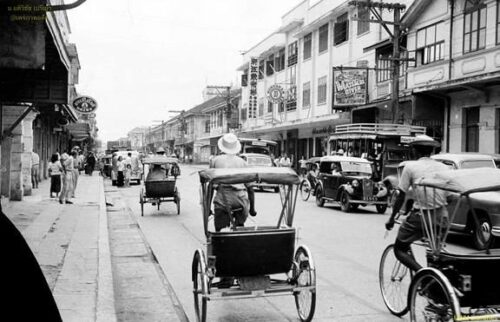Bangkok, the vibrant capital city of Thailand, holds a storied history that spans centuries, deeply rooted in a rich cultural tapestry and marked by a series of transformations. From its humble beginnings as a small trading post to becoming a bustling metropolis, Bangkok’s history is a fascinating journey of resilience, royal influence, colonial encounters, and cultural amalgamation. In this blog, we will delve into the captivating history of Bangkok, exploring its rise as a powerful city and the factors that have shaped its unique identity.
Table of Contents
Ancient Roots
 เรื่องเล่าเก่าๆ กรุงเทพในอดีตเฟสบุคเพจ
เรื่องเล่าเก่าๆ กรุงเทพในอดีตเฟสบุคเพจ
Bangkok’s history dates back to the 15th century when it was known as “Krung Thep,” meaning “City of Angels.” The area around the Chao Phraya River was already inhabited, and it served as a strategic trading post due to its proximity to the Gulf of Thailand. However, the city’s prominence increased in 1767 when the former capital of Ayutthaya was destroyed by the Burmese. King Taksin the Great, a courageous leader, established Thonburi as the new capital on the western banks of the river, later moving it across to the eastern banks where present-day Bangkok stands.
The Rise of the Chakri Dynasty
 trueplookpanya.com
trueplookpanya.com
In 1782, King Rama I, the founder of the Chakri Dynasty, ascended the throne and established Bangkok as the new capital of Thailand (then known as Siam). Under his reign, the city underwent significant development, including the construction of the Grand Palace, which became the royal residence. The Chakri Dynasty continues to reign in Thailand to this day, making it one of the world’s longest-serving royal families.
Colonial Encounters
 King Rama 5
King Rama 5
Throughout the 19th century, Bangkok found itself caught in the colonial rivalry between European powers. Siam managed to maintain its independence by skillfully navigating between the British and the French, who sought to establish their spheres of influence in Southeast Asia. King Chulalongkorn (Rama V), who ruled from 1868 to 1910, was instrumental in modernizing Siam and implementing crucial reforms that helped the nation retain its sovereignty.
Modernization and Infrastructure
 Bangkok Tram
Bangkok Tram
During the late 19th and early 20th centuries, Bangkok city of Thailand underwent significant modernization efforts. King Chulalongkorn introduced administrative reforms, abolished slavery, and restructured the government. The construction of roads, railways, and the establishment of the first electric tramway contributed to the city’s growth and accessibility.
World War II and Aftermath
During World War II, Thailand found itself facing the dilemma of balancing its relations with both Japan and the Allied forces. In 1941, Japanese forces invaded Thailand, which then aligned itself with Japan. However, after the war, Thailand emerged from the conflict relatively unscathed and began to rebuild and strengthen its economy.
Economic Boom and Urbanization
From the 1960s onwards, Bangkok city of Thailand experienced an economic boom, driven by agriculture, manufacturing, and tourism. Bangkok became the epicenter of this growth, attracting people from all over the country seeking opportunities in the expanding urban landscape. The city’s skyline transformed with the rise of modern high-rise buildings and skyscrapers, symbolizing Thailand’s progress and economic prosperity.
Challenges and Resilience

Bangkok’s rapid urbanization also brought about challenges, including traffic congestion, pollution, and socio-economic disparities. The city’s infrastructure struggled to keep up with the surging population, leading to issues of urban planning and sustainable development. Despite these challenges, the people of Bangkok displayed remarkable resilience and adaptability, finding innovative solutions to address urban problems.
Cultural Heritage and Temples

Throughout its history, Bangkok has been a center of culture and spirituality, evident in its magnificent temples and cultural landmarks. The Grand Palace, Wat Pho, and Wat Arun are among the most revered and iconic temples, showcasing intricate architecture and housing sacred relics. The city’s numerous festivals, such as Songkran (Thai New Year) and Loy Krathong, add to its cultural vibrancy and offer a glimpse into the traditional way of life.
Modern Bangkok City of Thailand: A Global City

Today, Bangkok stands as a bustling global city, known for its dynamic nightlife, world-class shopping, and diverse culinary scene. The city has embraced its role as a major hub in Southeast Asia, attracting travelers, expatriates, and businesses from around the world. Bangkok’s position as a leading destination for medical tourism and its prominence in the film industry further contribute to its international appeal.
Preserving Heritage and Embracing the Future
As Bangkok forges ahead into the future, it remains committed to preserving its unique cultural heritage while embracing modernity. The city continues to invest in infrastructure development, green spaces, and sustainable initiatives to ensure a livable and vibrant environment for its residents and visitors alike.
In conclusion, Bangkok’s history is a captivating tale of evolution and resilience, shaped by the legacy of its monarchs, the trials of colonial encounters, and the unwavering spirit of its people. From a small trading post to a thriving metropolis, Bangkok’s journey is a testament to the city’s ability to adapt and grow while staying true to its cultural roots. As we embrace the future, Bangkok’s captivating history will undoubtedly continue to inspire and enchant generations to come.
When travelling to Bangkok, hiring a private tour guide and customize your own itinerary would help saving your time to explore and learn about the city and you would see a lot more than average tourists.

